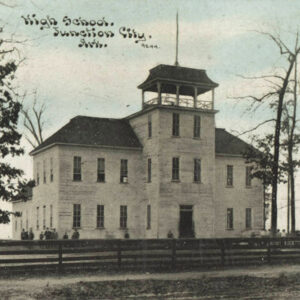calsfoundation@cals.org
Junction City (Union County)
| Latitude and Longitude: | 33º00’59″N 092º43’28″W |
| Elevation: | 197 feet |
| Area: | 1.14 square miles (2020 Census) |
| Population: | 503 (2020 Census) |
| Incorporation Date: | February 21, 1895 |
Historical Population as per the U.S. Census:
|
1810 |
1820 |
1830 |
1840 |
1850 |
1860 |
1870 |
1880 |
1890 |
1900 |
|
– |
– |
– |
– |
– |
– |
– |
– |
– |
1,251 |
|
1910 |
1920 |
1930 |
1940 |
1950 |
1960 |
1970 |
1980 |
1990 |
2000 |
|
1,065 |
653 |
814 |
797 |
1,013 |
749 |
763 |
813 |
674 |
721 |
|
2010 |
2020 |
|
|
|
|
|
|
|
|
|
581 |
503 |
|
|
|
|
|
|
|
|
Junction City is the southernmost city in Arkansas. Straddling the state line with Louisiana, Junction City has two city governments and exists in Union County, Arkansas; Union Parish, Louisiana; and Claiborne Parish, Louisiana.
Junction City was created by the Arkansas Southern Railway Company, which was formed by the directors of the South Arkansas Lumber Company. Both businesses were incorporated in August 1892, and the railroad began building a line from El Dorado (Union County) south to the state line. It reached the state line in 1894, and Junction City was platted at that time. Lots were auctioned at a public barbecue. Many of the successful bidders were from the town of Blanchard Springs in Union County; when their homes and businesses were established in Junction City, Blanchard Springs was slowly abandoned. A post office was opened in the new city in October 1894. At first it was called “Junction,” but the full name was approved by the postal service in 1897. Junction City was incorporated in 1895. The original buildings of the city were made of wood, but after several fires around the turn of the century, the damaged wood structures were replaced with brick buildings.
A well was dug near the center of Junction City early in its history. The well, which was located on the state line, was mentioned in Ripley’s Believe-It-Or-Not around the middle of the twentieth century. It had a trough for livestock as well as drinking-water facilities for people, but it no longer exists. Junction City now has two water towers, one in Arkansas and the other in Louisiana.
Prohibition of the sale of alcohol was prevalent in Arkansas at the time the city was founded. Though alcohol was not yet banned statewide, southern Union County had already voted itself dry. Louisiana did not yet have such laws. As a result, many of the new citizens and businesses in Junction City relocated south of the state line. Citizens Bank of Junction City was established in 1890, the second bank in Union County. Three businessmen opened a large store in Junction City, and W. D. Dismuke published a weekly newspaper, the Interstate News. Sidney Umsted operated a sawmill in Junction City from 1901 until 1905, when he moved his operation to Smackover (Union County).
While the two cities—one in Arkansas and one in Louisiana—have been separately incorporated, they share a school system and a volunteer fire department. By the middle of the twentieth century, both Louisiana parishes had become dry, and most Junction City homes, churches, and businesses were located in Arkansas. Segregated schools operated in Junction City into the 1960s. They taught children from both states, though they were all built on the Arkansas side of the state line. Before desegregation, Junction City’s Rosenwald school, which served African American students, was well known for its state championship basketball team, which even played in a national tournament in 1955. Following desegregation, the Junction City high school football team, which plays at the 2A level, became one of the more successful teams in Arkansas, winning state championships most recently in 2003, 2008, 2009, 2012, 2013, and 2014.
A tornado began near Junction City shortly before midnight January 12, 2005. The F-3 tornado traveled twenty-four miles through Union County, killing two people, injuring thirteen, and damaging much property.
For additional information:
Cordell, Anna Harmon. Dates and Data of Union County, Arkansas, 1541–1948. Monroe-Lafayette, LA: Century Printing & Publishing Inc., 1984.
Deane, Ernie. “Quiet Prevails on the Border in Junction City.” Arkansas Gazette, September 4, 1956.
“Junction City Dates from 1894.” El Dorado Daily News, March 22, 1970, p. 17A.
“Junction City Has Problem: It’s in 2 States, 3 Counties.” Arkansas Gazette, April 15, 1965.
Pumphrey, Wayne. “Border-Town Football Unites Both Arkansas, Louisiana.” Arkansas Sports360, July 2009, p. 43.
Whitten, Clayte, and Dewey Finley. “Junction City, Born with Railroad, in Unique Position in Two States.” El Dorado Daily News, May 19, 1957, p. 12.
Steven Teske
Butler Center for Arkansas Studies
 Junction City High School
Junction City High School  Union County Map
Union County Map 




I was raised in Junction City, Arkansas, for thirteen years. I thank God for my family and my childhood.
My father and his father and other relatives were residents of Junction City (I was raised in Malvern). My father (Elvus A. Cupp Jr.) was born there in 1919.